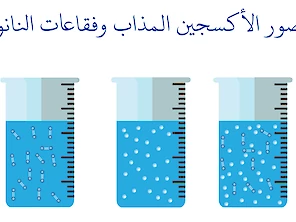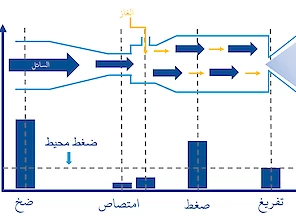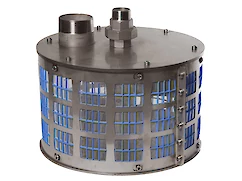الطفو
القوة الصاعدة في السوائل

في العلوم، الطفو أو الدفع لأعلى، هو قوة تصاعدية يبذلها مائع لأعلى تعارض وزن جسم مغمور. في عمود المائع، يزداد الضغط في عمود المائع مع زيادة العمق نتيجة لوزن المائع الذي يعلوه. وبالتالي، يكون الضغط عند قاع عمود المائع أكبر منه عند قمة العمود. وبالمثل، يكون الضغط عند قاع جسم مغمور في مائع أكبر منه عند قمة الجسم. وينتج عن فرق الضغط هذا قوة محصلة مؤثرة لأعلى على الجسم. ويتناسب مقدار هذه القوة المؤثِّرة مع فرق الضغط هذا (كما يوضِّح مبدأ أرشميدس) ويعادل وزن المائع الذي كان سيشغل حجم الجسم، أي المائع المُزاح.
ولهذا السبب، يميل الجسم الذي تكون كثافته أكبر من كثافة المائع الذي يُغمر فيه إلى الغرق. إذا كان الجسم إما أقل كثافة من السائل أو كان شكله مناسبًا (كما هو الحال في القارب)، يمكن للقوة أن تُبقي الجسم طافيًا. لا يمكن أن يحدث هذا إلا في إطار مرجعي له مجال جاذبية أو يتسارع بسبب قوة أخرى غير الجاذبية تحدد اتجاهًا "لأسفل" (أي إطار مرجعي غير قصوري). في حالة حالة إحصائيات الموائع، تكون قوة الطفو المحصلة لأعلى مساوية لمقدار وزن المائع الذي أزيح بواسطة الجسم.
المصدر: ويكيبيديا الطفو
روابط
50 روابط لصفحات أخرى: الطفو
مولدات الفقاعات النانوية الصناعية وأنظمة الأكسجين المتكاملة من Acniti. هندسة يابانية موثوقة وموثوقة لتربية الأحياء المائية ومعالجة المياه.
تقنية فقاعات النانو من أكنتي، معلومات حول العلم وراء هذه التقنية.
مولدات أكنتي لفقاعات النانو وتعزيز النمو وتحسين التنظيف والتطهير. مستويات عالية من الأكسجين المذاب.
أكنيتي هي شركة تصنيع معدات فقاعات النانو ومُكثفات الأكسجين الصناعية. تختص شركة أكنيتي في بيع وتسويق تكنولوجيا فقاعات النانو. تعد تكنولوجيا فقاعات النانو الثورة التالية في المياه والسوائل لتغيير خصائصها عن طريق إذابة الغازات لتعزيز العمليات البيولوجية والابتكار في التنظيف والتعقيم في مجموعة واسعة من التطبيقات.
أصول وموارد العلامة التجارية أكنيتي، أسلوب الشركة الداخلية.
شروط الخدمة وسياسة الخصوصية الخاصة بشركة أكنتي للفقاعات بتكنولوجيا النانو & ومزوِّد مُكثِف الأكسجين، أوساكا اليابان
مقالات مدونة وأخبار حول الفقاعات النانوية وتكنولوجيا الفقاعات متناهية الصغر ومكثفات الأكسجين.
الفقاعات في كل مكان من حولنا ، في أطعمتنا ، والبيرة ، ومشروبات البوب ، والخبز والجبن ، ولكن أيضًا في أحجار منزلنا. الفقاعات عبارة عن تجاويف مملوءة بالغاز في الماء ، وعمر الفقاعة قصير على الأكثر لبضع دقائق ، فقط الفقاعات فائقة الدقة تكون ثابتة لفترات أطول مثل الأشهر ، وهذا يجعلها مميزة للغاية ويمكننا من تغيير خصائص ماء.
اكتشف جهاز GaLF فائق الدقة GaLF، وهو مولد متطور يوفر أعلى تركيز للفقاعات النانوية في صناعة الفقاعات النانوية. مصمم للباحثين والجامعات والمختبرات، وهو مثالي للأبحاث الأساسية وتطوير المنتجات. وبفضل أدوات التحكم PLC المتقدمة وخيارات الغاز المرنة، تضمن هذه الوحدة المدمجة والقوية أعلى أداء وسهولة التشغيل. اقرأ المزيد لمعرفة كيف يمكن للفقاعات النانوية تعزيز التنظيف ونمو النباتات وصحة الأسماك.
يُعد جهاز miniGaLF نموذجًا بدائيًا من أجهزة GaLF وهو مصمم للشركات والجامعات ومعاهد البحوث والأفراد الذين يرغبون في التعرف على تقنية الفقاعات الدقيقة جدًا.
حلول GaLF المخصصة المضمنة في تطبيقاتك ، هذا نموذج من الفولاذ المقاوم للصدأ. مناسب للهيدروجين والبنزين.
تخيل أن أرضية المطبخ أو الحمام يتم تنظيفها بواسطة فقاعات صغيرة جدًا. يبدو رائعًا، فقد بدأ عصر تكنولوجي جديد.
إن miniGALF هو نموذج GaLF مبتدئ IDEC المصمم للتجارب الأولى مع تقنية فقاعات النانو. يتيح miniGaLF-Plus تركيزًا أعلى من فقاعات النانو عن طريق ممرات متعددة للمياه عبر miniGaLF.
فيلم فقاعات النانو، فيلم باستخدام Malvern NanoSight. استنادًا إلى هذا الفيلم، يقوم سوفتوير NanoSight الداخلي بحساب عدد الفقاعات لحساب تركيز عدد الفقاعات وحجم الفقاعة.
تحدث الأشياء العظيمة عندما يتفق العالم ، والفقاعات الدقيقة هي تقنية مبتكرة ، ولكن بدون معايير مناسبة لتطوير الصناعة ، هناك عقبات. منذ عام 2013 ، بدأت ISO في إنشاء معيار دولي للفقاعات الدقيقة المعروفة باسم فقاعات النانو.
صفحة الاتصال علي شركة "أكنتي" إذا كان لديك أي استفسار حول منتجاتنا ، كيفية عملها، فوائدها ، أسعارها، تواصل معنا عبر صفحتنا .
هناك تقنيات مختلفة لتوليد فقاعات النانو (فقاعات متناهية الصغر). تقدم هذه المقالة نظرة عامة على التقنيات الأكثر استخدامًا ، مثل الانحلال المضغوط ، والخلاطات الساكنة ، والتدفق الدوراني.
طريقة جديدة ومبتكرة لنقل الأسماك أثناء النوم جاهزة تقريبًا للذهاب إلى السوق. مزيج من CO2 والفقاعات متناهية الصغر يجعل هذا ممكنًا.
فقاعات النانو هي عبارة عن تجاويف مملوءة بالغاز في الماء. منطقة التلامس بين الفقاعات في الماء المليء بالفقاعات الصغيرة أكبر بكثير من المياه المليئة بالفقاعات الأكبر. يكون ضغط الغاز داخل الفقاعة الصغيرة أعلى منه في الفقاعة الكبيرة ، وبالتالي يكون التوتر السطحي للفقاعة الصغيرة أعلى أيضًا.
فلاتر التنظيف الذاتي تمنع انسداد المضخات وتجعل التهوية أكثر كفاءة. هذه المضخة ممتازة أيضًا كفلاتر لنزح المياه لتصريف الخزانات أو المناطق المغمورة. يشرح هذا الفيديو طريقة العمل الداخلية لفلتر المياه الذكي هذا.
فلاتر المدخل، تجنب سد المضخات وتحافظ على حياة مائية آمنة. الفلاتر قابلة للتركيب على المضخات الغاطسة والعادية.
فيديو عرض مرشح المدخل ذاتي التنظيف. ترشيح فعال وتصميم مبتكر لمياه نظيفة.
الفردي RF100 هو أصغر فلتر مدخل (مصفاة) ذاتي التنظيف. يصفي حتى 30 لترًا / الدقيقة وتم تصميمه لحماية المضخات والمعدات الأخرى. هذا الفلتر القوي والموثوق به سهل التركيب. فهو مضغوط وخفيف الوزن ولديه وصلات بسيطة. رائع للاستخدامات الزراعية والصناعية الخفيفة حيث يوجد حاجة إلى تصفية المياه. تستخدم المصفاة 20 - 25٪ من طاقة المضخة لدفع الدوران الخلفي الداخلي للغسيل، وتنظيف الشبكة بأكملها كل ½ ثانية. يتم الحفاظ على الرواسب والحياة البرية والصلبة المعلقة بعيدًا عن شبكة المصفاة.
RF200 هو فلتر ذاتي التنظيف للتوصيل بخرطوم الشفط للمضخات المثبتة على السطح. يمكن تزويدها بشبكة فلتر نايلون متينة أو شبكة من الفولاذ المقاوم للصدأ متكلس ويمكن ترشيحها من 60 إلى 315 ميكرون. تصل سعة فلاتر RF200 إلى 220 لترًا في الدقيقة. تحتوي جميع الفلاتر على دوار تنظيف داخلي ، وهو يعمل بالماء عن طريق إخراج "T" من خرج المضخة لتزويد الدوارات الداخلية للفلتر. يقوم هذا الإمداد بغسل الشاشة الشبكية بشكل عكسي بشكل مستمر بحيث يدفع بعيداً أي شيء قد يسبب انسداد الشبكة. يمكن أن تعمل هذه الفلاتر في المياه المتسخة جدًا دون سد ، مما يقلل من الحاجة إلى خزانات الاستقرار ويقلل من الصيانة إلى الحد الأدنى.
يعد غسل الأسطح والغسيل من المجالات الواعدة التي يمكن أن تحدث فقاعات النانو فرقًا في التطبيق. إن تقليل كمية المنظفات له تأثير إيجابي عن طريق تقليل التلوث. وغسل الملابس بدون منظفات من شأنه أن يفيد البيئة بشكل كبير. يمكن لفقاعات النانو أن تخفض التوتر السطحي للماء ، والكميات الكبيرة من جزيئات الأكسجين في الفقاعات تشحن الماء سالبًا.
يوفر فلتر ومصفاة الشفط الذاتي RF600 قوة صناعية وتصفية ذات صيانة منخفضة للمضخات المثبتة على السطح. وهي عبارة عن فلاتر قوية من الفولاذ المقاوم للصدأ التي تحمي المضخات والمعدات المتصلة الأخرى من الانسداد عند ضخ المياه القذرة. توفر آلية التنظيف الحائزة على جائزة في الفلاتر غسلًا مستمرًا يحافظ على شبكة الفلتر خالية من الأعشاب والحطام والمواد الصلبة الأخرى المعلقة. يمكن لل RF600 التعامل مع 90 متر مكعب إلى 275 متر مكعب في الساعة.
تقبل أكنيتي المدفوعات البنكية و TransferWise و PayPal والعديد من بطاقات الائتمان الرئيسية فيزا و ماستركارد و American Express و Discover و JCB و Diner's Club و EnRoute تقبل أكنيتي المدفوعات بالعملات التالية: اليورو ، والين الياباني ، والدولار الأمريكي ، والجنيه الإسترليني ، والدولار الأسترالي ، والدولار النيوزيلندي ، والدولار السنغافوري
هل أنت مهتم بمعرفة سبب تسمية فقاعات النانو رسميًا بالفقاعات فائقة الدقة؟ في هذه المقالة نوضح الأسباب التي دفعت اللجنة الفنية ISO قررت استخدام الاسم الرسمي فقاعات متناهية الصغر بدلاً من فقاعات النانو.
خس مانوا هو نوع من أنواع الخس المعرضة للإصابة بحروق الأطراف. حرق الأطراف هو تجفيف وموت أنسجة الأوراق على طول حواف الورقة. خلال اختبار في مزارع في هاواي تبين أنه من خلال زيادة مستويات الأكسجين المذاب وإضافة فقاعات متناهية الصغر يتم تقليل حروق الأطراف وتتحسن الجودة والإنتاج.
تعرّف على الطفو في السوائل وحلول أكنيتي المبتكرة لمعالجة المياه بالنانو فقاعات.
البروبيوتيك الكائنات الحية الدقيقة الحية التي تعزز الفوائد الصحية للزراعة وتربية الأحياء المائية ومعالجة المياه
تتنافس بروبيوتيك المقدمة من أكنيتي الزراعية مع الميكروبات الضارة. تساعد الأنواع المختلفة من البكتيريا الموجودة في صورة أقراص على إزالة مصدر الطعام للبكتيريا الضارة. يجب حل أقراص الفوار في الماء.
غالبًا ما يكون تكاثر الطحالب سببًا لبدء معالجة الأحواض. يمكن أن يؤدي استخدام البروبيوتيك مع الفقاعات فائقة الدقة إلى زيادة كفاءة عملية معالجة مياه الصرف الصحي. توفر أكنيتي البروبيوتيك على شكل أقراص بطريقة سهلة وآمنة لجرعة البكتيريا المفيدة وتطبيقها.
فوائد تربية بروبوتيك الأحياء المائية
مُكثّف الأوكسجين أوكسيتي الصناعي بمكونات عالية الجودة من اليابان وأمريكا ، مبني في غلاف ألومنيوم متين التصميم. يستخدم المكثف تقنية امتصاص تأرجح الضغط (PSA) وينتج 8 لتر من الأوكسجين في الدقيقة. توفر هذه الوحدة راحة البال وساعات عديدة من إنتاج الأكسجين المستقر.
miniGaLF هو نموذج GaLF لمستوى المبتدئ الخاص بشركة أكنتي وهو مصمم للشركات والجامعات ومعاهد البحوث والأفراد الذين يرغبون في التعرف على تقنية الفقاعات فائقة الدقة. في هذه المدونة ، يتم عرض فيلم عن التوصيلات والأداء لإنشاء فقاعة متناهية الصغر (فقاعات نانو) ذات نسبة عالية من الأكسجين المذاب.
فقاعات النانو مفيدة في تسريع عملية التمثيل الغذائي للكائنات الحية، لكن الآلية ليست مفهومة جيدًا بعد. في دراسة، قاموا بالتحقيق في إنتاج أنواع الأكسجين التفاعلية (ROS) بواسطة فقاعات النانو وتأثيرها على إنبات البذور. كانت نتيجة الدراسة أن البذور الموجودة في ماء فقاعات النانو لها معدل إنبات أعلى من كل تلك المغمورة في المحاليل التقليدية الأخرى المستخدمة.
إعداد مضخة Tsurumi 50TM.275 لخلاط فقاعات النانو توربيتي الغاطس للمياه المالحة.
إعداد مضخة معالجة المياه Tsurumi 50 PN2.75 لخلاط فقاعات النانو توربيتي 737 الغاطس.
تأكد من الأداء الأمثل لمولد الفقاعات متناهية الصغر الخاص بك مع جهاز استشعار الفقاعات النانوية المتناهية الصغر ALT-9F17 - وهو مستشعر متطور للفقاعات النانوية يوفر مراقبة دقيقة وفي الوقت الحقيقي باستخدام طريقة الليزر المتناثرة. اكتشف كيف يساعدك هذا الحل المدمج وسهل الاستخدام على التحكم في جودة المياه وتقليل التكاليف وتعزيز الكفاءة التشغيلية. استكشف مواصفاته الرئيسية وميزاته وفوائد تطبيقه لإطلاق العنان لإدارة المياه بشكل فائق.
خيار المضخة لـ miniGaLF و Lowara PM21 ، تعد المضخة جزءًا من خيار miniGaLF Plus ، استخدم المضخة لإنشاء تركيز أعلى من فقاعات النانو
خيار المضخة لـ miniGaLF و Ebara PRA 0.50 ، تعد المضخة جزءًا من خيار miniGaLF Plus ، استخدم المضخة لإنشاء تركيز أعلى من فقاعات النانو
صمام فحص سواغيلوك لminiGaLF لإعادة تدوير الماء في الخزان وإنتاج تركيز عالي من الفقاعات الدقيقة جدًا.
خيار مضخة أيبارا لخلاط فقاعات النانو الأوزون توربيتي 3LM4 40-160 / 0.55
صمام فحص الغاز الأكسجين المطلوب لجميع خلاطات فقاعات النانو لتجنب دخول الماء إلى مُكثّف الأكسجين
اكتشف مضخات العينات عالية الأداء من Acniti، المصممة بخبرة للاستخدام مع مستشعر الفقاعات النانوية ALT ومستشعرات تركيز الماء بالأوزون. تضمن هذه المضخات المصممة بمتغيرات قوية مقاومة للتآكل وقياسية تحليل دقيق وموثوق للمياه للمختبرات والتطبيقات الصناعية. كما أن توافقها ومتانتها وتصميمها المبتكر يجعلها ضرورية للقياسات الدقيقة القائمة على المستشعرات في المراقبة البيئية ومراقبة الجودة.
cartridge filter 2~7μm for the ALT 9F17 to remove micro bubbles and particles before analyzing the number of nano-bubbles
عوامة لخلاط فقاعات النانو الغاطس. بهذه الطريقة يسهل وضعها في الماء
تعتبر الخصائص الكهربائية للفقاعات الغازية مهمة في تحديد تفاعل فقاعات النانو عند دمجها مع بعضها البعض وكيفية تفاعلها مع مواد أخرى مثل الجسيمات الصلبة أو قطرات الزيت. ويساعد فهم هذا الأمر في تطوير التطبيقات، على سبيل المثال، مزيلات البروتينات، وتعويم الرغوة، ومعالجة الأغذية، وغسل الأسطح والتنقية.







